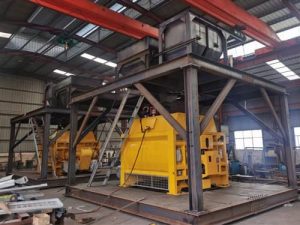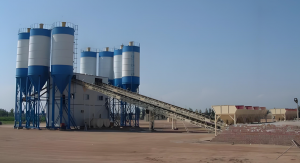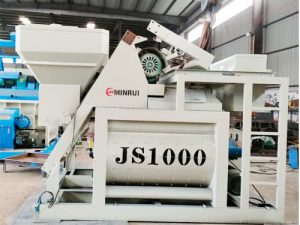Relative News
Products
In the context of the current booming infrastructure construction, the Minrui 75m3/h HZS75 concrete batching plant, as the backbone of medium-sized concrete batching plant production equipment, its technical characteristics and application value are worth in-depth discussion.
This article will systematically introduce the technical parameters, structural composition, working principle, performance advantages, selection and configuration, operation and maintenance, and market application prospects of the HZS75 concrete plant, providing a comprehensive reference for engineering technicians and equipment purchasers.、
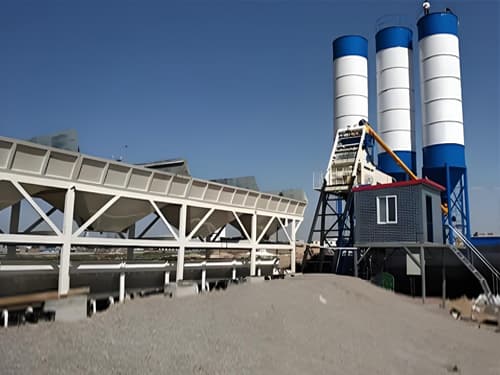
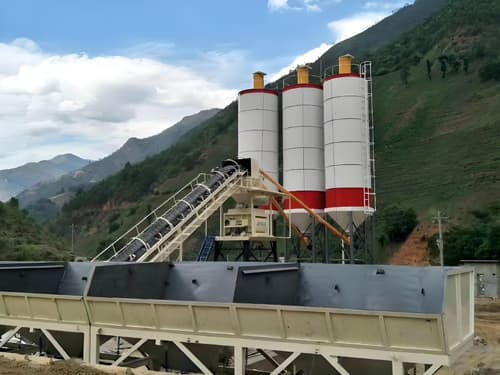
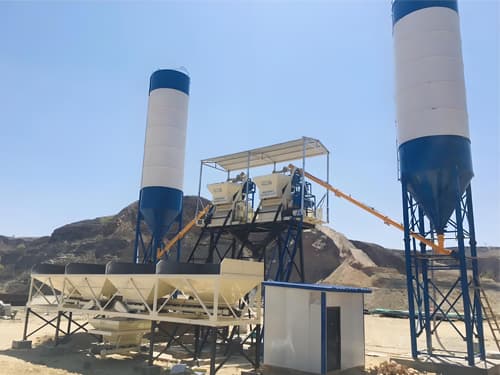
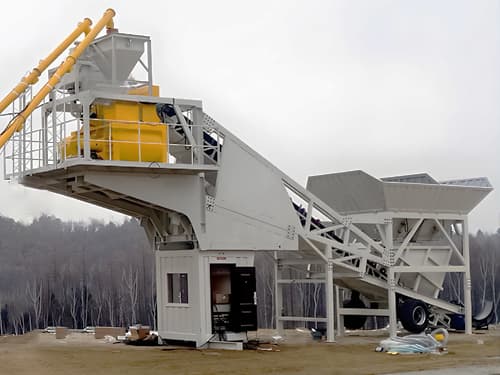
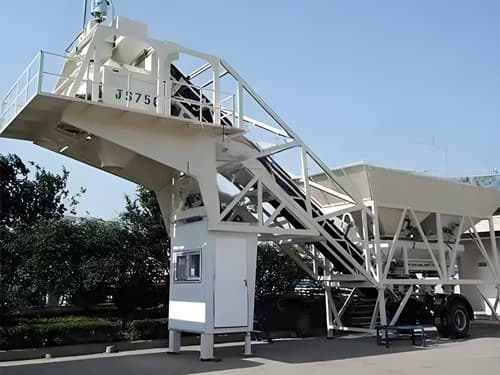
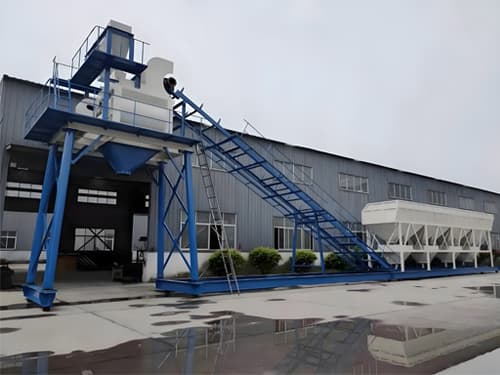
1. Overview and technical parameters of HZS75 concrete batching plant
1.1 Basic definition and positioning of HZS75
Minrui Group HZS75 concrete batching palnt is a fully automatic concrete production equipment with modular design. In the “HZS” series naming, “H” represents concrete, “Z” represents mixing station, “S” refers to twin-shaft mixer, and “75” indicates that its theoretical productivity is 75 cubic meters per hour.
HZS75 concrete batching plant belongs to the category of medium-sized mixing plants, filling the market gap between small-scale engineering needs and large commercial mixing batching plants. HZS75 concrete batching plant is particularly suitable for medium-sized construction projects with a construction period of 6-18 months.
1.2 Detailed explanation of core performance parameters
Production capacity: rated production rate 75m³/h, actual output is usually maintained at 60-70m³/h due to material ratio and operating efficiency
Mixer: standard Minrui 1.5m3 JS1500 twin-shaft forced concrete mixer, mixing capacity 1.5m³/time, mixing cycle 60-72 seconds.
Batching system accuracy:
Aggregate weighing error ≤±2%
Cement and admixture error ≤±1%
Water metering error ≤±1%
Additive error ≤±0.5%
Aggregate silo configuration: standard 4-silo design, single silo volume 18-25m³, expandable to 6 silos.
Powder storage: conventional configuration 2-3 sets 100 ton cement silos, optional fly ash silos with 1 set 100 ton capacity.
Installed power: total power about 120-150kW (excluding aggregate drying system)
1.3 Equipment of HZS75 concrete batching palnt specifications and installation requirements
Machine weight: about 45-55 tons (depending on the configuration)
Floor space: minimum installation size is about 50mx30m (L x W)
Discharge height: 3.8-4.1 meters (customization)
Control mode: fully automatic PLC control + manual emergency mode
Environmental protection standards: meet the noise and dust emission requirements of GB/T 9142-2023 “Concrete Batching Plant”.
2. Equipment structure and core technology analysis
2.1 Main functional modules
(1) Aggregate supply system
Adopts “belt feeding + cumulative metering” method, including:
Storage silo: four independent silos, with anti-blocking vibration device inside
Belt conveyor: belt width 800-1000mm, belt speed 1.25m/s, tilt angle 18°
Weighing hopper: weighing sensor adopts high-precision strain gauge type, with a range of 0-3000kg.
(2) Powder storage and transportation system
Cement silo: diameter φ2.8-3.2m, cylindrical cone bottom structure, equipped with level meter and arch breaking device
Screw conveyor: diameter φ273/219mm, conveying capacity 80t/h, tilt angle 30-45°
Measuring device: adopts pressure sensor, sealed and dust proof design.
(3) Core components of mixing system
Mixer of plant: Minrui JS1500 mixer type, dual motor drive (2x30W), shaft end adopts labyrinth & grease double seal
Liner and blade: wear-resistant alloy material, hardness HRC55-60, service life ≥80,000 tanks
Discharge door: hydraulic drive, opening time ≤3 seconds, excellent sealing performance.
(4) Liquid addition system
Water metering: three-way valve control, flow meter calibration, temperature sensor monitoring
Admixture system: independent metering pump, corrosion-resistant stainless steel pipeline
(5) Intelligent control system
Hardware configuration: industrial-grade PLC (Siemens / Boshuo / Etc series) 10-inch touch screen
Software functions:
Recipe storage ≥100 groups
Production data recording and tracing
Fault self-diagnosis and alarm
Remote monitoring interface (optional)
2.2 Analysis of key technical highlights
(1) Two-stage process flow design
Adopting the “vertical layout” method: aggregate is lifted by belt → metering → secondary lifting → mixing, saving 30% of site space compared with the single-stage method.
(2) Application of energy-saving technology
The mixing motor adopts variable frequency control, and the starting current is small
The gas circuit system is equipped with an intelligent drainage device
The belt conveyor is equipped with energy-saving rollers
(3) Environmentally friendly and innovative design
The main building of HZS75 concrete batching plant is fully enclosed & pulse dust collector (dust removal efficiency ≥ 99.5%)
Wastewater recycling and reuse system
Overall noise control ≤ 75dB (A)
3. Performance advantages and comparison with similar products
3.1 Core competitive advantages of HZS75
Efficiency and economy: The unit production capacity equipment investment is 15% lower than that of HZS90 concrete batching plant, and the energy consumption cost is 12% lower than that of HZS50 concrete batching plant.
Adaptability: HZS75 concrete batching plant can produce concrete of various strength grades from C10 to C80. Supports a variety of special concretes such as ordinary, fiber, and lightweight aggregates
Reliability indicators:
Mean time between failures (MTBF) ≥ 500 hours
Equipment utilization rate can reach more than 85%
4. Selection, configuration and installation and operation guide
4.1 Customized configuration plan
Basic configuration: including mixing system, aggregate batching, powder metering, control system
Recommended options:
Aggregate pre-wetting system (reduce dust)
Waste slurry water recovery device (water saving 30%)
Smart card management system (applicable to commercial mixing stations)
Containerized control room (harsh environment)
4.2 Key points of site planning
Geological requirements:
Foundation bearing capacity ≥ 150kPa
Concrete foundation thickness ≥ 400mm
Set up drainage ditches and water collection wells
Layout principles:
Aggregate yard ≤ 50m away from the main engine
Cement tank 15-20m away from the main engine
Leave a 10m wide equipment access channel
4.3 Installation and commissioning process
Foundation acceptance: horizontality deviation ≤ 3mm/m
Main body hoisting:
First install the mixing main engine base
Then set up the batching layer frame
Finally install the powder silo
Electrical wiring: Note that the grounding resistance is ≤ 4Ω
No-load test: The running time of each mechanism is ≥ 4 hours
Load test: Continuous production verifies the measurement accuracy
4.4 Production and operation management
Staffing:
1 operator (certified)
1 mechanic (also quality supervisor)
1-2 loader drivers
Daily checklist:
Lubrication system oil level
Air line pressure (0.5-0.7MPa)
Sensor zero drift
Loose fasteners
5. Maintenance and troubleshooting
5.1 Preventive maintenance plan
Daily maintenance:
Clean the residual material in the mixing tank
Check the wear of the liner
Clean the dust collector filter
Monthly maintenance:
Replace the reducer lubricant
Calibrate all weighing systems
Test the safety limit device
Annual overhaul:
Replace worn blades and liners
Replace motor bearings
Anti-corrosion treatment of steel structures
5.2 Common fault diagnosis guide
Fault phenomenon Possible cause Solution
Inaccurate measurement Sensor drift/air line leakage Recalibrate/replace air pipe
Main engine abnormal noise Liner detachment/bearing damage Stop for inspection/replace parts
Belt deviation Improper roller adjustment/material eccentricity Adjust tensioning device/uniform feeding
Low air pressure Air compressor failure/pipeline leakage Repair air compressor/find leak
No response from PLC Power failure/program error Check power supply/restart system.
6. Market application and investment return analysis
6.1 Typical application scenarios
Transportation engineering: secondary roads, railway culverts, airport taxiways
Construction engineering: residential buildings below 18 floors, industrial park buildings
Water conservancy engineering: small and medium-sized dams, irrigation channels
Special applications:
Prefabricated component factory support
Military engineering rapid deployment
Post-disaster emergency reconstruction
6.2 Investment benefit calculation (taking the commercial concrete station as an example)
Initial investment (China Yuan):
Equipment purchase: 350,000-450,000 yuan
Infrastructure: 20,000-50,000 yuan
Supporting equipment: 10,000-20,000 yuan
Total: about 500,000 yuan
Operating costs:
Power consumption: 1.2-1.5kWh/m³
Labor: 15,000 yuan/month
Maintenance: 8,000 yuan/month
Benefit analysis:
Based on 70% capacity utilization (52.5m³/h)
Working 10 hours a day, monthly output 15,700 m³
Calculated based on regional price difference of 50 yuan/m³
Monthly gross profit of about 785,000 yuan
Investment payback period of about 5-7 months
6.3 Market development trend in 2025
Technical direction:
Popularization of remote operation and maintenance system of Internet of Things
Pilot operation of hydrogen energy mixing station
Special configuration for 3D printing concrete
Policy impact:
New national standard has higher requirements for energy consumption
Carbon tax policy promotes equipment renewal
County demand driven by rural revitalization
7. Conclusion
HZS75 concrete batching plant maintains stable demand in the current construction market with its moderate production capacity, flexible configuration and reliable quality performance.
With the development of intelligent and green manufacturing technology, the new generation of Minrui HZS75 concrete batching plant equipment is evolving towards a more efficient and environmentally friendly direction.
When purchasing, users should comprehensively consider factors such as project scale, construction period requirements, environmental protection standards, etc., and at the same time pay attention to the supplier’s after-sales service capabilities.
Proper use and maintenance can extend the service life of the equipment to more than 10 years, creating continuous value for investors.
Potential buyers are advised to visit the Minrui HZS75 concrete batching plant equipment operation site on site to obtain first-hand performance data so as to make the best investment decision.
